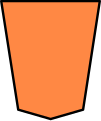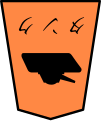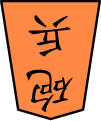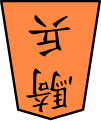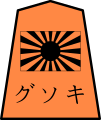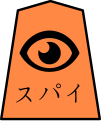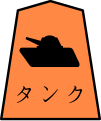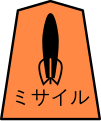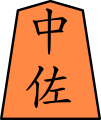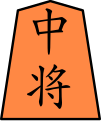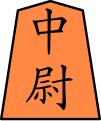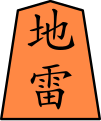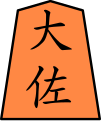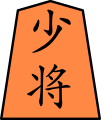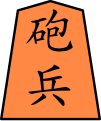Category:Gunjin Shōgi (orange pieces)
Jump to navigation
Jump to search
Pieces Name
|
Strength | 23[1] | 25[2] | 31 | Notes |
|---|---|---|---|---|---|
| Board size (home area) | 6×4 | 9×3 | 8×4 | Typically has "bridges" over a river, represented by the center of the board, with either straight, X, or Y shapes. Bridges are not counted as a separate row: the squares connected by the bridges are considered to be adjacent to each other. Military headquarters occupy the 2 or 3 squares in the center of the row closest to each player. | |
| Individual pieces and quantities | |||||
| General 大将 |
14 | 1 | 1 | 1 | The flag officers can move one adjacent space forward, backward, left, or right. |
| Lieutenant General 中将 |
13 | 1 | 1 | 1 | |
| Major General 少将 |
12 | 1 | 1 | 2 | |
| Colonel 大佐 |
9 | 1 | 2 | 2 | The senior officers can move one adjacent space forward, backward, left, or right. |
| Lieutenant Colonel 中佐 |
8 | 1 | 2 | 2 | |
| Major 少佐 |
7 | 1 | 2 | 2 | |
| Captain 大尉 |
6 | 2 | 0 | 2 | The junior officers can move one adjacent space forward, backward, left, or right. |
| Lieutenant 中尉 |
5 | 2 | 0 | 2 | |
| 2nd Lieutenant 少尉 |
4 | 2 | 0 | 2 | |
| Engineer 工兵 |
2 | 2 | 3 | 3 | Engineers can move like a rook in chess, over any number of empty squares forward, backwards, left, or right, similar to the scout in L'Attaque and Stratego. They cannot jump over occupied squares. |
| Plane 飛行機 |
11 | 2 | 0 | 2 | The plane can move forward or backward any number of squares, or move left or right one square. It can jump over other pieces. Planes beat all pieces except flag officers (generals, lieutenant generals, and major generals). |
| Jet ジェット機 |
0 | 2 | 0 | In the 25-piece game, the jet can move to any square except to squares occupied by friendly pieces or the opponent's marshal. | |
| Tank タンク |
10 | 2 | 2 | 3 | Tanks follow the same movement rules as Cavalry for the 23- and 31-piece games; for the 25-piece game, they follow the same movement rules as Engineers. Tanks beat all pieces except generals, planes, engineers, and mines. |
| Cavalry 騎兵 |
3 | 1 | 0 | 2 | Cavalry can move forward two squares in a single turn, or use regular movement rules (one adjacent square). These pieces cannot jump other pieces when moving forward two squares. Cavalry only beat spies and engineers. |
| Artillery 砲兵 |
0 | 2 | 0 | Artillery follows the same movement rules as the Engineers. | |
| Spy スパイ |
1 | 1 | 1 | 1 | The spy can only beat the general. For the 25-piece game, the spy follows the same movement rules as the engineers; for the other games, the spy follows the same one-square movement rules as the general and field officers. |
| Mine 地雷 |
— | 2 | 2 | 3 | Mines are a single-use item; they are removed after being attacked, along with the attacking piece unless attacked by an engineer. Mines may not be placed at the entrances or exits to bridges. In the 8×6 example board shown, mines cannot be placed at B5, E5, B4, or E4. |
| Missile ミサイル |
— | 0 | 2 | 0 | Movement is similar to the jet, unrestricted except to squares occupied by friendly pieces or the opponent's marshal. By itself, the missile removes all pieces in the four adjacent squares (forwards, backwards, left, and right) from where it fell, unless one of those squares is occupied by an opponent's missile, in which case only the two missiles are removed. |
| Atomic bomb 原爆 |
— | 0 | 1 | 0 | Immobile unless adjacent to a missile, in which case the pieces can be moved together. When the missile enters the opponent's camp, all pieces in the eight adjacent squares (forwards, backwards, left, right, and diagonally) from the bomb's square are removed, unless one of those squares is occupied by an opponent's missile, in which case only the two missiles and the atomic bomb are removed. |
| Flag 軍旗 |
varies | 1 | 0 | 1 | The flag's strength is determined by the piece behind it. |
| Marshal 元帥 |
— | 0 | 1 | 0 | The marshal is immobile and takes the place of the flag for the 25-piece game. Vulnerable to attack only by a flag or senior officer, and only when there are no adjacent friendly pieces. |
- ↑ 軍人将棋の紹介〔ルール解説含む〕. chushogi-renmei.com (December 17, 2000). Retrieved on 18 July 2023.
- ↑ 日本軍人将棋連盟ホームページにようこそ. tanken.com. Retrieved on 18 July 2023. "駒や盤の取り方などは時代によって(あるいは製造元によって)多少異なるようです。第1次大戦後にはタンクや地雷が、第2次大戦後には毒ガスや飛行機、原爆が登場するなど、現実の戦争に応じて、次々と進化を遂げてきました。[Pieces and boards differ slightly depending on when or who manufactured them. After World War I, tanks and mines were included, and after World War II, poison gas, airplanes, and atomic bombs were added.]"
Media in category "Gunjin Shōgi (orange pieces)"
The following 46 files are in this category, out of 46 total.
-
Shogi io01.svg 42 × 50; 751 bytes
-
Shogi ioグソキ.svg 42 × 50; 4 KB
-
Shogi ioゲンバク.svg 42 × 50; 3 KB
-
Shogi ioジエツト.svg 42 × 50; 1 KB
-
Shogi ioスパイ.svg 42 × 50; 2 KB
-
Shogi ioタンク.svg 42 × 50; 2 KB
-
Shogi ioヒコーキ.svg 42 × 50; 2 KB
-
Shogi ioミサイル.svg 42 × 50; 2 KB
-
Shogi io中佐.svg 42 × 50; 1 KB
-
Shogi io中将.svg 42 × 50; 1 KB
-
Shogi io中尉.svg 42 × 50; 1 KB
-
Shogi io元帥.svg 42 × 50; 1 KB
-
Shogi io地雷.svg 42 × 50; 1 KB
-
Shogi io大佐.svg 42 × 50; 1 KB
-
Shogi io大将.svg 42 × 50; 1 KB
-
Shogi io大尉.svg 42 × 50; 1 KB
-
Shogi io少佐.svg 42 × 50; 1 KB
-
Shogi io少将.svg 42 × 50; 1 KB
-
Shogi io少尉.svg 42 × 50; 1 KB
-
Shogi io工兵.svg 42 × 50; 1 KB
-
Shogi io砲兵.svg 42 × 50; 1 KB
-
Shogi io軍旗.svg 42 × 50; 1 KB
-
Shogi io騎兵.svg 42 × 50; 1 KB
-
Shogi o00.svg 42 × 50; 751 bytes
-
Shogi oグソキ.svg 42 × 50; 4 KB
-
Shogi oゲンバク.svg 42 × 50; 3 KB
-
Shogi oジエツト.svg 42 × 50; 1 KB
-
Shogi oスパイ.svg 42 × 50; 2 KB
-
Shogi oタンク.svg 42 × 50; 2 KB
-
Shogi oヒコーキ.svg 42 × 50; 2 KB
-
Shogi oミサイル.svg 42 × 50; 2 KB
-
Shogi o中佐.svg 42 × 50; 1 KB
-
Shogi o中将.svg 42 × 50; 1 KB
-
Shogi o中尉.svg 42 × 50; 1 KB
-
Shogi o元帥.svg 42 × 50; 1 KB
-
Shogi o地雷.svg 42 × 50; 1 KB
-
Shogi o大佐.svg 42 × 50; 1 KB
-
Shogi o大将.svg 42 × 50; 1 KB
-
Shogi o大尉.svg 42 × 50; 1 KB
-
Shogi o少佐.svg 42 × 50; 1 KB
-
Shogi o少将.svg 42 × 50; 1 KB
-
Shogi o少尉.svg 42 × 50; 1 KB
-
Shogi o工兵.svg 42 × 50; 1 KB
-
Shogi o砲兵.svg 42 × 50; 1 KB
-
Shogi o軍旗.svg 42 × 50; 1 KB
-
Shogi o騎兵.svg 42 × 50; 1 KB
